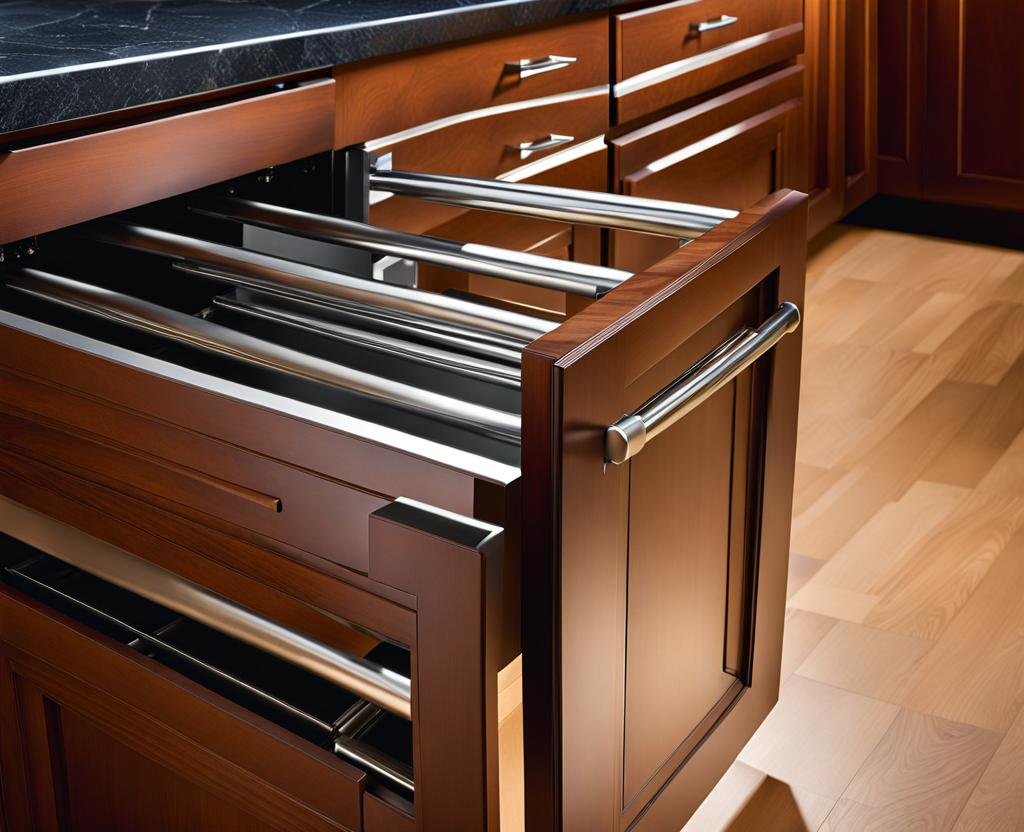The placement of your cabinets’ hardware is very important. Meticulously planned cabinet hardware positioning adheres to industry standards, ensuring a cohesive, visually appealing space. As an experienced interior designer, I understand the nuances involved in achieving this delicate balance.
From ergonomics to style preferences, mastering cabinet hardware placement standards empowers you to create a harmonious environment. Join me as we explore the intricacies of this art, uncovering insider tips to refine your space with sophistication.
Cabinet Hardware Positioning Fundamentals
Before delving into the intricate details, let’s establish a solid foundation by examining the fundamentals of cabinet hardware positioning. Adhering to these core principles ensures a seamless blend of practicality and visual appeal, setting the stage for a refined interior.
Firstly, comprehending standard measurements is crucial. Generally, hardware should be placed approximately one-third down from the top edge for upper cabinets and one-third up from the bottom edge for lower cabinets. This strategic placement not only optimizes accessibility but also contributes to a visually balanced aesthetic.
Additionally, consistency is key. Maintaining uniform distances between hardware pieces across cabinetry creates a harmonious flow, guiding the eye effortlessly throughout the space. Whether you opt for knobs or pulls, symmetry should reign supreme, instilling a sense of order and cohesion.
Ergonomics of Cabinet Hardware Placement
Beyond mere aesthetics, thoughtful cabinet hardware positioning caters to user comfort and ease of access. As a designer, ergonomics play a pivotal role in my creative process, ensuring that functionality seamlessly intertwines with form.

For instance, consider the placement of hardware on cabinet drawers. Strategically positioning knobs or pulls towards the top third of the drawer face facilitates a natural grip, reducing strain on the wrist and forearm. This subtle adjustment not only enhances usability but also contributes to the overall refinement of the space.
Tailoring to User Needs
Furthermore, I advocate tailoring hardware placement to the unique needs of the individuals inhabiting the space. For households with elderly members or those with mobility challenges, lowering hardware positions can significantly improve accessibility. Similarly, accommodating varying heights within a family ensures a comfortable experience for all.
Embracing these ergonomic principles not only exhibits thoughtful design but also demonstrates a commitment to creating inclusive environments that prioritize user well-being.
Aesthetic Considerations for Cabinet Hardware Locations
While functionality reigns supreme, the allure of aesthetics cannot be understated. Refined cabinet hardware placement demands a keen eye for visual harmony, striking the perfect balance between form and function.
One pivotal consideration is the hardware’s relationship with the cabinetry’s overall style. For instance, sleek, minimalist designs may call for understated hardware placements, allowing the cabinetry’s clean lines to take center stage. Conversely, ornate, traditional cabinets often complement hardware positioned slightly off-center, lending a touch of whimsy and character.
Additionally, I often advocate for hardware placements that accentuate the cabinet’s architectural features. Strategically positioning knobs or pulls to highlight intricate carvings or distinctive panel designs can elevate the overall aesthetic, transforming ordinary cabinetry into a statement piece.
Popular Cabinet Hardware Arrangement Styles
Within the realm of cabinet hardware placement, a multitude of popular styles have emerged, each offering a distinct visual identity. As a discerning designer, I firmly believe in tailoring these approaches to suit the unique vision and preferences of my clients.
The classic centered approach, for instance, exudes timeless elegance. By positioning hardware equidistant from the cabinet’s edges, a sense of symmetry and balance prevails, lending a refined, sophisticated ambiance to the space.
For those seeking a more contemporary flair, the off-center style offers a refreshing departure from convention. This bold approach often involves placing hardware towards the top or bottom corners, creating a visually striking contrast that commands attention.
Embracing the concept of mixed hardware can also yield captivating results. Combining knobs and pulls, or experimenting with varying finishes, introduces an element of playfulness and individuality, allowing your personal style to shine through.
Expert Tips for Flawless Cabinet Hardware Installations
Mastering cabinet hardware placement standards extends beyond mere positioning; meticulous attention to detail during the installation process is paramount. As a seasoned professional, I’ve honed numerous techniques to ensure a flawless, long-lasting result.
One invaluable tip is to carefully measure and mark hardware locations before drilling. This simple step prevents costly mistakes and ensures precise alignment, contributing to the overall polished appearance.
Additionally, I recommend investing in high-quality hardware screws designed specifically for cabinetry. These specialized screws not only provide a secure hold but also minimize the risk of splitting or cracking the cabinet material.
For an extra touch of refinement, consider incorporating drawer liners or cabinet organizers into your design. These subtle accents not only enhance functionality but also elevate the overall aesthetic, showcasing your commitment to a cohesive, well-executed vision.
As we conclude our exploration of cabinet hardware placement standards, allow me to share a comprehensive checklist to ensure you’ve covered all bases:
- Adhere to industry-standard measurements for upper and lower cabinets
- Maintain consistent distances between hardware pieces
- Prioritize ergonomics and user comfort
- Complement the cabinetry’s overall style and design
- Experiment with popular hardware arrangement styles
- Meticulously plan and execute hardware installations
- Incorporate drawer liners and cabinet organizers for added refinement
By diligently following these guidelines, you’ll unlock the true potential of your cabinetry, transforming it into a showcase of impeccable taste and functionality. Embrace the art of cabinet hardware placement, and revel in the refined ambiance it cultivates within your cherished living spaces.

This is where you’ll find inspiration to create a stylish and beautiful dream home.